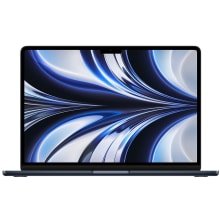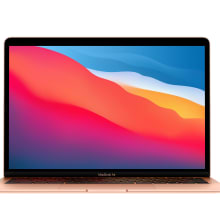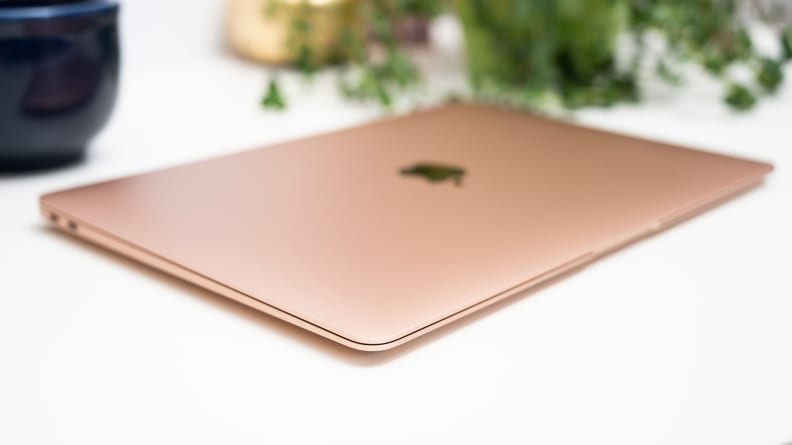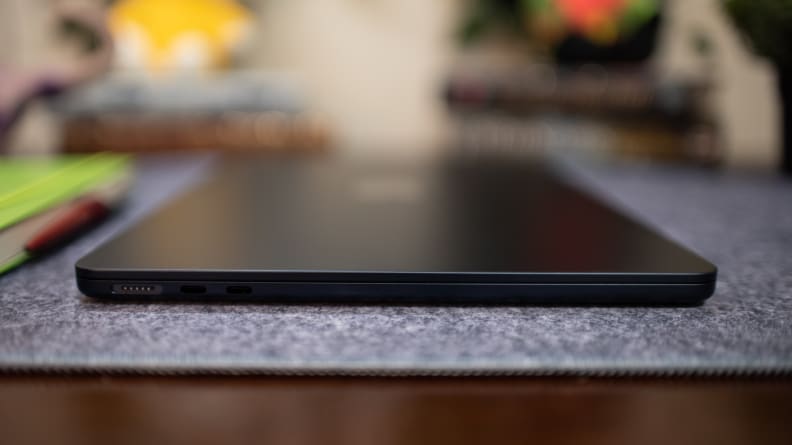Which should you choose, the Apple MacBook Air M1 or the M2?
Our editors choose products independently. Purchases made through our links may result in a commission.
The MacBook Air 13 lineup is more diverse than ever. The MacBook Air 13 M3 has significant performance increases over the MacBook Air 13 M2, although it is otherwise nearly identical to the earlier model. Meanwhile, the MacBook Air M1 still holds its own as an older laptop, and while its display isn't nearly as good as the M2 model, it's still superior to the display on many computers under $1,000.
The 2022 MacBook Air M2 sports an improved display, camera, cosmetics, and battery life compared to the previous edition. It is a significant advance over the MacBook Air M1 (2020), and while it is more expensive than the M1, it is worthwhile if you have the funds.
It's worth noting that this only applies to the 13-inch versions; the MacBook Air 15 M2 has a 15-inch screen.

Apple MacBook Air M2
The 13-inch MacBook Air M2 outperforms the M1 version in almost every regard, according to the MacBook Air M1 review.

Apple MacBook Air M1
The MacBook Air M1 is still a viable option for productivity activities and is significantly less costly than the M2 variant.
Features of MacBook Air M1 compared. MacBook Air M2

A full-height function row is one among the many new features on the MacBook Air M2.
The MacBook Air M1 is a stunning notebook. Its near-weightless, small design makes it a no-brainer to pack your MacBook in your bag wherever you go, and the MacBook Air M2 is even thinner.
Both computers are amazing; however, they have somewhat different color schemes. You cannot obtain a gold MacBook Air M2 or a blue-black MacBook Air M1. (Either way, fans of Apple's iconic Space Gray will be pleased.)
There are also some minor variances between the keyboard and trackpad. The MacBook Air M1's trackpad is already massive, but the MacBook Air M2's trackpad is somewhat larger. The MacBook Air M2 also replaces the MacBook Air M1's half-height function row on the keyboard with a full-height row.
The MacBook Air M2's most notable feature changes are its 1080p webcam and the addition of a MagSafe charging connection. One of the biggest complaints about the MacBook Air M1 is the lack of a separate charging connector. It only has two Thunderbolt ports and one headphone jack.
The Air M2's extra charging port eliminates the need to jam one of your two Thunderbolt ports while charging. The MacBook Air M2's 1080p camera is a significant improvement over the MacBook Air M1's 720p webcam, which is grainier and requires more lighting to appear nice.
In terms of audio performance, the MacBook Air M1 comes out on top. Apple chose to remove the grilles from the MacBook Air M2 chassis and incorporate them between the display and keyboard. If the audio seems muffled, that's because it is.
It is unsatisfactory. Both MacBook Air versions have the same audio drivers. However, even though the M2 MacBook Air has four speakers (two tweeters and two woofers) and the M1 just has stereo speakers, the M1 sounds cleaner since it not only has traditional speaker grilles but the speakers are placed more attentively.
Our recommendation: MacBook Air M2.

Apple MacBook Air M2
The 13-inch MacBook Air M2 outperforms the M1 version in almost every regard except pricing.
Read our review.
MacBook Air M1 vs. MacBook Air M2 Display

The MacBook Air M2's display outperforms the M1 for individuals who watch a lot of HDR video.
While the M1 MacBook Air's display is stunning, the M2 offers a few enhancements. The M1 features a 13.3-inch Liquid Retina display with a resolution of 2560 x 1600 pixels, 400 nits of peak brightness, and support for millions of colors throughout the P3 color gamut. The MacBook Air M2 features a Super Retina display, a 13.6-inch 2560 x 1664 pixel panel with 500 nits of peak brightness and support for billions of colors in the P3 color gamut.
In regular use, the two screens will seem extremely similar. They both support the entire sRGB and P3 color gamuts, with almost comparable pixel density (the M1 model is 1% denser), and are bright enough for use in a well-lit workplace.
If you often view HDR video or employ gradients in your daily life, the MacBook Air M2 has a modest edge. While the additional pixels theoretically provide a somewhat bigger work surface, in fact, the horizontal strip of display that corresponds to the camera notch on the MacBook Air M2 is blacked out in many programs.
Overall, the MacBook Air M2 wins because of its increased brightness and improved color gradients.
Our recommendation: MacBook Air M2.

Apple MacBook Air M2
The 13-inch MacBook Air M2 outperforms the M1 version in almost every regard except pricing.
MacBook Air M1 vs. MacBook Air M2: Processing Performance
The Apple Silicon M2 CPU is an enhanced version of Apple's M1 processor. The newest processor's cores are somewhat more powerful and significantly more efficient than the M1's. The MacBook Air's M1 and M2 CPUs each have eight cores, four for speed and four for efficiency.
For basic tasks such as visiting a webpage or writing a paper, single-core speed will be more important than multicore performance. When one core can do a task, your computer will not need to distribute the burden over numerous cores. Tasks with many moving elements, such as editing a Photoshop file or playing a video game, will use many cores (and consume your battery quicker because they require more power).
The M2's advantages over the M1 are more apparent in multicore performance than in single-core performance. It's just 11% quicker in single-core operations, but the M1 can already open twenty tabs in Google Chrome before dragging, for example.
Meanwhile, the M2 processor performs 15% to 18% quicker in multicore activities. If you're a strong power user or intend on pushing your MacBook Air to its limits, you'll notice a minor improvement in performance. The M2 also boasts a dedicated ProRes decoding engine, so media makers will gain the most from the change. Otherwise, the M1 is already strong enough.
Our recommendation: MacBook Air M2.

Apple MacBook Air M2
The 13-inch MacBook Air M2 outperforms the M1 version in almost every regard except pricing.
MacBook Air M1 vs. MacBook Air M2: Storage Speed and Performance

The M1 outperforms the other laptops in terms of storage speed.
Unfortunately, the MacBook Air M2's storage read and write rates are much slower than the MacBook Air M1's when ordered with 256GB of storage due to Apple's drive configuration. In our tests, the MacBook Air M2's SSD was up to 50% slower than the MacBook Air M1's.
With such a significant loss in speed, downloading and installing files will take longer, as will uploading and accessing files. If you often transfer or reference data, such as in gaming or video editing, the processing improvements are not worth the storage lag. This may be fixed by upgrading to the 512GB MacBook Air M2, which costs an additional $300.
Our recommendation: MacBook Air M1

The MacBook Air M1 is still a viable option for productivity activities and is significantly less costly than the M2 variant.
Read our review.
Buy now (7% off)
Save $50 at Walmart.
MacBook Air M1 vs.rsus MacBook Air M2 batteLifeife
Windows laptops built with Intel or AMD processors struggle to compete with the MacBook Air M1. It can run for 11 hours and 42 minutes on a full battery before needing to be recharged.
However, these are low-end values when compared to the MacBook Air M2, which lasts 17 hours and 10 minutes. (The Microsoft Surface Laptop 7th Edition is the longest-lasting Windows laptop we've tested, lasting over 23 hours.).
The M2's longer battery life is due in part to its significantly larger battery capacity. Its 52.6-watt-hour lithium polymer battery is a significant improvement over the M1's 49.9-watt-hour battery, and the M2's more efficient power usage extends its lifespan even further.
The M2 also charges faster because of its MagSafe charging connector. The M1 model can only charge via USB-C. To charge either laptop, use the M1's bundled 30W USB-C port compact power adapter; however, any USB-C charger will do. Still, the MacBook Air M2's accompanying peripherals are impressive—it includes a MagSafe to USB-C connection and a 35W twin USB-C port compact power converter that can charge two devices at the same time.
If you want even longer battery life, you may choose between the MacBook Pro 13 M2 (19 hours and two minutes) and the MacBook Pro 16 M1 Max (22 hours and 32 minutes).
Our recommendation: MacBook Air M2.

Apple MacBook Air M2
The 13-inch MacBook Air M2 outperforms the M1 version in almost every regard except pricing.
MacBook Air M1 versus MacBook Air M2: Specifications and Price
Both versions start with 8GB of RAM and 256GB of storage, although the MacBook Air M2 costs $150 more at the time of writing. However, any enhancements you make to either model will cost the same.
While both laptops may be upgraded to 2TB of storage, the MacBook Air M2 has more RAM (unified memory) than the M1—up to 24GB vs. 16GB.
The Air M1 features a 7-core GPU, whereas the Air M2 has an 8-core GPU. If you need more graphics capability, the M2 features an optional 10-core GPU.
While most people will be content with the base model of either laptop, if you want to future-proof it, you should consider acquiring at least 16GB of RAM and a 512GB storage drive. When comparing the M1 with the M2, the amount of memory and storage will have a greater impact on your daily experience than the CPU.
That being said, the base MacBook Air M1 is an excellent laptop for $699 (and even better for $649), while the base M2 model is commonly available for $799 now.
Our recommendation: Tie.
The winner is the MacBook Air M2.

The MacBook Air M2 is the winner.
The MacBook Air M2 is the superior notebook, while the MacBook Air M1 is a close second.
If you can afford to pay $100 or more, depending on sales, the MacBook Air M2 is a better option. It features a separate charging connector, a brighter screen, a better camera and keyboard, much longer battery life, and somewhat greater processing power.
The MacBook Air M1 is a great option for individuals wishing to save some money. It's older, so it's more likely to stay on sale, and you won't be losing anything. The MacBook Air M1 features a battery life of over 12 hours and a vibrant, color-accurate 2K Retina display. It also sounds better than the MacBook Air M2, and its quicker storage speeds bridge the performance gap between the two laptop CPUs.
The changes to the MacBook Air M2 appear to be more of a luxury than a necessity. You cannot go wrong with any laptop.

Apple MacBook Air M2
The 13-inch MacBook Air M2 outperforms the M1 version in almost every regard except pricing.

